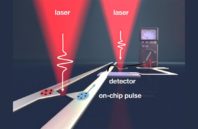Scientists at the Technical University of Munich (TUM) have demonstrated that 14 femtosecond optical pulses in the near-infrared can drive electronic on-chip circuits with a prospective bandwidth up to 10 terahertz.Published in Nature, the research could enable the development of new, powerful terahertz (THz) components.
To combine the advantages of ultrafast femtosecond nano-optics with an on-chip communication scheme, optical signals with a frequency of several hundreds of THz need to be down-converted to coherent electronic signals propagating on-chip. Traditional electronics allows frequencies up to around 100 gigahertz, whereas optoelectronics uses electromagnetic phenomena starting at 10 terahertz (THz). This range in between is referred to as the terahertz gap, since components for signal generation, conversion and detection have been extremely difficult to implement.
TUM physics professors Alexander Holleitner and Reinhard Kienberger succeeded in generating ultrashort electric pulses in the frequency range up to 10 terahertz using metal antennas only a few nanometres in size, and then running the signals a few millimetres above the surface and reading them in again a controlled manner. Researchers call antennas plasmonic if, because of their shape, they amplify the light intensity at the metal surfaces.

 (585) 768-2513
(585) 768-2513

